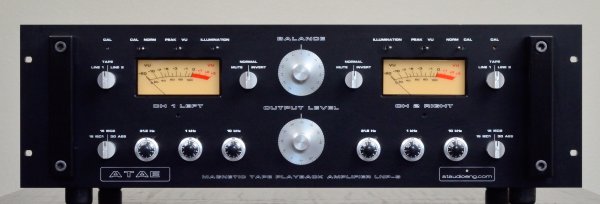Hello Ron,
You and Roger are asking good questions and I appreciate your interest.
First, ATAE's product offerings have always been conceived and developed entirely for the pro market. More specifically, the people who own large (and sometimes immensely large!) archives of priceless, original master tapes. Mainly, I'm talking about the Big Three: Universal, Sony and Warner. As you may know, the Big Three haven't shown much interest. But that's another topic entirely.
Now, as to what tape playback amplifiers are included with a Model One or Two, this has always been optional. We let the customer decide. Not unlike some audiophiles, the people who are inside major recordings archives and record labels working hands-on every day with high-value master tapes, can be very opinionated and stubborn about what they prefer to use. So we give them choices.
Right now we have about five. Among those choices are indeed some mildly, or even extensively re-done classic Studer circuits, often constructed on original Studer factory circuit boards. And often with quite a few parts left out, or bypassed, or changed to something else. Here's an obvious example: why on earth would anyone want FET switching in the audio signal path to permit sync playback in a circuit intended for state-of-the-art playback of highest quality master tapes?
One area where the pro community and the audiophile community appear to be completely diverging is over adjustability to meet the standard playback eq curves. And I do not mean at just two or three points across the band. The top pros are looking at this in one-third, one-sixth or even one-twelfth octave resolution! If your box won't align flat (meaning within a quarter or half of a dB) to all the corresponding multifrequency or chromatic sweep MRL cal tapes, they will laugh you out the door.
One additional point I see too often glossed over when audiophiles talk tape playback electronics, is that you have to design the first stage for a known repro head. At minimum, you have to know the inductance to some degree of accuracy. There is also an optimum load impedance that the first stage must present to the repro head. So any box that says "connect (some unknown?) tape head here" is highly suspect of being totally disqualified from the start.
When I first started learning about designing high-quality tape playback electronics 35 years ago (and just as this was not my field of expertise then, neither is it now) I was very fortunate to have just really, really excellent mentors. Names you've heard of. What I learned from these great teachers was that there can be a awful lot to it. Analog audio circuit design is not trivial. So I continue to rely on only the very best analog circuit designers I can find. Ones who understand the demanding requirements imposed by the tape playback equalizations, and the best ways to get there.
View attachment 30111



